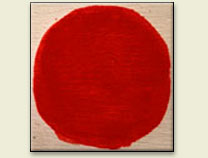
Painted swatch of Vermilion.
Brief description of Vermilion:
An orangish red pigment with excellent hiding power and good permanence. It's a mercury sulfide mineral (cinnabar) used from antiquity through to the present though only scarcely due to its toxicity. Made artificially from the 8th century (vermilion), it was the principle red in painting until the manufacture of its synthetic equivalent, cadmium red.
Names for Vermilion:
| Alternative names: | natural variety: cinnabar; artificial variety: vermilion | ||||||
| Word origin: | The name "Vermilion" comes from Latin vermiculus = small worm, cochineal (which yields a red dye), from vermis = worm. | ||||||
| Non-English names: |
|
||||||
| Origin: | mineral (cinnabar) and artificial | ||||||
| Chemical name: | mercuric sulfide |
Example of use by artists:
Assumption to Heaven, dress Vermilion

Tiziano Vecellio, Assunta, 1516-1518, Santa Maria gloriosa dei Frari, Venezia
Titian used Vermilion to create the reds in the great fresco of Assunta, completed c. 1518.

